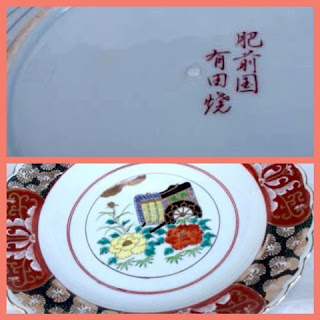
You are invited to come along with me as I learn about Japanese ceramics. I will share what I learn about the kilns, history, terminology, potters, decorators, styles, and marks. This is a work in progress. ** NOTICE: I DO NOT ANSWER QUERIES ON PERSONAL PIECES. I DO NOT GIVE VALUATIONS. General comments and questions will still be accepted.
Friday, August 26, 2016
Bakumatsu Blue
While researching ceramics of the Edo Bakumatsu period (roughly 1853-1867) I noticed a blue color combination (medium gray/blue with a darker, but not cobalt blue, often with (墨弾) Sumihajiki, a resist method used to on ceramics to leave white areas when painted or glazed. I will call this "Bakumatsu Blue". Not all ceramics made during the Bakumatsu period used this blue combo, but it was widespread. Similar combinations were used much earlier in the Edo period with slight variations.
Tuesday, August 23, 2016
Japanese Military and Memorial Sake Cups
This is certainly a work in progress. I will continue to add as I find examples.
SITES FOR RESEARCHING
https://www.militaryantiquesmuseum.com/js388-1930s-japanese-sake-cup.15048.archive.htm
Friday, August 19, 2016
Yamatoku with additional decorator marks
I am researching Yamatoku marked plates that include additional markings. It appears that Yamatoku produced blanks which were then decorated by others. I have found several marked by decorators.
Hizen Arita decorated
Tetsuka or Tezuka is often found with the Yamatoku impressed mark
This mark is sometimes found on Yamatoku pieces.
 |
| Thanks to Maggie Xiao for permission to use her pictures |
Hizen Arita decorated
Tetsuka decorated
The Yamatoku ヤマトク mark is at the top with the red
Tetsuka テツカ mark (up side down) on the bottom.
Here is an example of a Taisho era blue mark with Yamatoku impressed mark
A Matsu mark with a roof meaning house of Matsu. The decorator?
Tuesday, August 9, 2016
Lefton China-imported from Japan
Lefton China was a US importer of Japanese china wares, figurines and novelties. Although the company was founded in 1941, it was after WWII that they imported wares. Some will have "Made in Occupied Japan" but most will just have some variation of Lefton China, Handpainted, Japan. The company was sold in 2000.
Subscribe to:
Posts (Atom)
Featured Post
Helpful Vocabulary When Researching Japanese Ceramics
Vocabulary when searching for Japanese Ceramics *I will be adding to this list Dating ( 江戸) Edo Period (1603-1868) (江戸 前期) Ea...
-
From 1921-1941, wares from Japan exported to the United States had to be marked "Japan" or "Made in Japan". During Wor...
-
The This company was in business from 1954-1994. It was bought out by Enesco in 1994. Registered in NYC and San Francisco. Recognized by it...
-
Kutani ware is from Ishikawa Prefecture. The markings are often in red, but can be impressed, in blue, gold and sometimes black with a g...
















